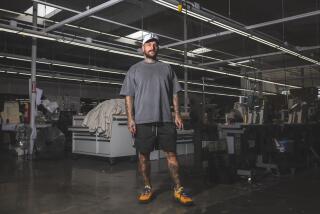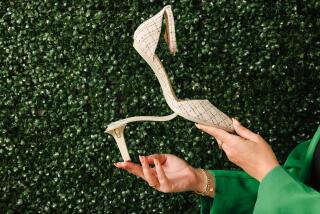Oakley Races to Enter Athletic Shoe Industry
- Share via
FOOTHILL RANCH — High-tech eye wear manufacturer Oakley Inc. on Wednesday took aim at sports apparel powerhouse Nike Inc. by announcing plans to enter the hotly competitive athletic footwear industry.
Oakley, best known for cutting-edge sunglasses sported by the likes of NBA superstar Michael Jordan, said it would begin production next year of footwear now being tested by athletes allied with the company.
Jim Jannard, founder and chairman of the company based in the South County community of Foothill Ranch, declined to describe what segment of the shoe market he plans to attack or whether footwear will eventually be as important to Oakley as its core sunglass business. But he promised that the shoes would be “decidedly different.
“There’s such a well-defined notion of what you can and can’t do in the footwear industry,” Jannard said. “Well, we’ve thrown out all the preconceived notions. . . . We’re going to use new materials, prototype them in a new way and manufacture them in Foothill Ranch.”
Oakley’s entry into footwear escalates the competition with Nike--and underscores a heated rivalry between Jannard and Nike founder and Chairman Phil Knight, whom Jannard counts as a friend.
The two companies, which have been trading lawsuits in recent weeks, are attacking each other’s strongholds. Nike recently unveiled a new line of eye wear that competes directly with Oakley.
But Oakley faces an uphill fight for market share in an industry where the two top players--Nike and Reebok International Ltd.--control 60% of the market. The retail value of athletic shoes sold in the U.S. hit $12.1 billion in 1996, according to the North Palm Beach, Fla.-based Sporting Goods Manufacturers Assn.
“The main things you need are a legitimate brand name and money--lots of money,” said John G. Horan, publisher of Glen Mills, Pa.-based Sporting Goods Intelligence, which estimates the wholesale market for branded athletic footwear at $7.5 billion.
“I haven’t seen what Oakley is proposing,” Horan said, “but the company isn’t widely distributed right now in the sporting goods industry.”
Some analysts suspect that Oakley might try to break into the footwear industry with specialized products for competition-level cyclists or sprinters. Broader distribution, though, could be dependent upon Oakley winning shelf space in national chains such as Foot Locker.
Oakley has been developing a line of apparel and accessories that includes caps, T-shirts and backpacks emblazoned with its distinctive logo.
“Jim Jannard is trying to do what some footwear companies are doing--get closer to head-to-toe coverage,” said Marcia L. Aaron, a San Francisco-based industry analyst for Alex. Brown & Sons. “Oakley is doing what a lot of companies are doing--building their brand.”
Oakley issued a news release about its nascent shoe line after fielding calls from curious people who’d seen athletes wearing Oakley prototypes. “It was only fair to let our investors know what’s going on upfront rather than having speculation grow,” Jannard said.
*
In July, Oakley sued Nike, alleging that the Beaverton, Ore.-based company’s new eye wear line infringed upon Oakley patents.
Earlier this month, Nike sued Oakley over an advertisement that shows Jordan--an Oakley board member--wearing Oakley shades and a beret with an Oakley logo.
Nike, which also has Jordan under contract to endorse its apparel and shoes, claims the NBA star has agreed not to wear competitors’ apparel. Nike, which did not comment on the suit, is seeking a court order prohibiting Oakley from running the ads.
Jannard acknowledged that the new shoe line will heat up competition with Nike.
“I had [a shoe] invention about seven years ago that I put on the shelf out of respect for a friend of mine in the shoe industry,” Jannard said. “But when I found out that the friend was going into the eye wear industry--contrary to earlier representations--I let him know that we really couldn’t be restrained anymore on our end.”
*
But Jannard said Oakley isn’t trying to co-opt Nike’s business.
“When we got into the sunglass industry, it wasn’t to take away business from Ray-Ban,” Jannard said. “We had an invention that went against the grain in the industry.
“Well, this is exactly the same thing. There will be a decided difference in what materials we use and how we manufacture our footwear.”
Oakley’s plan to produce shoes in the U.S. runs against the grain in an industry where the vast majority of footwear is produced in lower-cost plants in Asia and Europe.
“My understanding is that [Oakley] plans to do things differently in the manufacturing process to take out labor costs,” Aaron said. “And that’s what Oakley has managed to do in the eye wear industry--produce in the U.S. by taking out labor costs.”
Jannard said the shoe line is going forward because “we now have the time and capability to produce this new invention. Our drive for innovation is no longer constrained to optics.”
More to Read
Inside the business of entertainment
The Wide Shot brings you news, analysis and insights on everything from streaming wars to production — and what it all means for the future.
You may occasionally receive promotional content from the Los Angeles Times.









